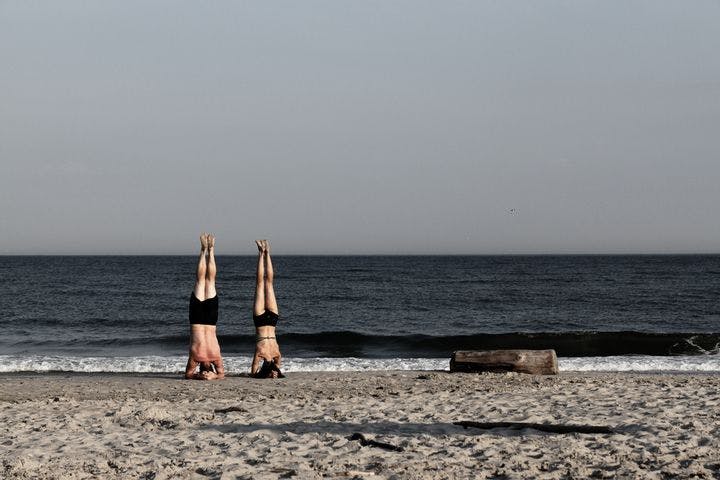Summer 2010
Sweat Equity
– Winfred Gallagher
How yoga went mainstream.
Victorian mores still dominated mainstream America at the dawn of the 20th century, but an eclectic proto-counterculture stirred in more adventurous circles. Spiritual teachers including the mystic G. I. Gurdjieff, the feminist evangelist Aimee Semple McPherson, and the prosperity-minded African-American minister Father Divine preached new religious ideas to big followings. Pierre Bernard has faded from the ranks of such well-known names, but the man who popularized yoga in the United States, where 20 million people now practice it, was once the much-chronicled glittering sage of the Jazz Age. In The Great Oom, he’s resurrected as an important cultural figure who blazed the trail for New Age spirituality and alternative health regimens.
Bernard’s life offers a particularly colorful iteration of the American success story, in which a lad from the heartland transcends his rustic beginnings to become a charismatic guru who was also hailed by Fortune magazine as a “shrewd and level-headed businessman.” Born into a struggling Iowa family in 1876, Perry Baker—he later took his stepfather’s surname and switched to the more stylish Pierre—was sent to live with a cousin in Lincoln, Nebraska, at age 13. In that improbably cosmopolitan university town, the intellectually curious teenager befriended a young neighbor interested in the occult and joined him in studying with the Sanskritist and yogi Sylvais Hamati. In 1893, Hamati and his new acolyte headed to California and eventually settled in San Francisco. Soon, the gorgeously turbaned and muscular Pierre Bernard was practicing his new skills on clients suffering from “nervous disorders.”
Although the famed Hindu yogi Swami Vivekananda had established his Vedanta Society outreach centers in California and New York by the turn of the century, Asian practices such as yoga and meditation were regarded as heretical and indecent by all but cosmopolitan elites. Moreover, Bernard’s salubrious ministrations were not always entirely spiritual. Although not particularly handsome, the Iowan guru was a gifted athlete who exuded energy and, apparently, sex appeal. When he began to preach as well as practice his exotic arts, rumors of sinuous nautch dancers and sex rituals attracted the attention of police and press. In 1906, he fled San Francisco in disgrace.
By 1910, Bernard had set up shop in New York City, where his seamy history seemed about to repeat itself. Headlines screamed “Arrest Hindu Seer,” and the newly dubbed “Great God Oom”—the extra “o” was a misspelling—was jailed for corrupting young girls in tights. Despite dark rumors of “white slavery,” the charges were dismissed, and, backed by society beauties such as Margaret Rutherfurd Mills and her mother, Anne Vanderbilt, within a few years Bernard was a celebrity.
Trading his turban for tweeds, Bernard set about refashioning yoga and Eastern religious ideas for an America increasingly interested in health and fitness as well as spiritual quests. With his lissome wife and best student Blanche DeVries, he established America’s first ashram on a Hudson River estate in Nyack, New York, which he cleverly called the Clarkstown Country Club. There and at venues in nearby Manhattan, devotees performed rigorous exercises, observed a careful diet, and practiced inner cleanliness (by giving themselves enemas) to prepare for the enlightened realization that “all is one.” Guests could also enjoy jazz, baseball, circuses complete with elephants, and lots of dexterous girls in scanty costumes. The chic ashram became a destination for celebrities the likes of Noel Coward, and Bernard was anointed by snooty Town & Country as “the Guru of Nyack.”
Now middle-aged, Bernard heeded his own advice to his closest disciples: “Live dangerously, carefully.” The former social pariah became a civic leader who brought a music school, an airfield, and other amenities to once sleepy Nyack. By the mid-1930s he was speaking at the Yale Club, Mae West and Greta Garbo were practicing yoga, and Cosmopolitan’s models were twisting themselves into attractive asanas(yoga postures).
The Great Depression and World War II brought America back down to earth, and mystical philosophies and alternative country clubs lost their appeal. After Bernard tried to raise money with a dog-racing track that later closed amid charges of corruption, he lost his health and fabled energy. Reunited with his Iowa family and his wife, from whom he had become estranged, he died in 1955 at the age of 78. The whiff of sulfur notwithstanding, the Great Oom had won fame and fortune and helped to prepare the way for the cultural changes that would revolutionize American society beginning in the 1960s.
Despite his outrageously colorful life, the cigar-smoking fitness guru remains an enigma. Like the fabled journalist Joseph Mitchell, who, as a cub reporter, profiled Bernard in 1931, Robert Love settles for his subject’s opaque self-description as a “curious combination of the businessman and religious scholar.” The Great Oom is more successful as an East-meets-West social history than as a biography, and helps explain how yoga became a mainstream fitness activity and why a quarter of the population is comfortable with Eastern religious beliefs such as reincarnation.
* * *
Winifred Gallagher writes about human behavior. Her most recent book, Rapt: Attention and the Focused Life, was published last year.
Reviewed: The Great Oom: The Improbable Birth of Yoga in America by Robert Love, Viking, 402 pp, 2010.
Photo courtesy of Flickr/Stefan Georgi
